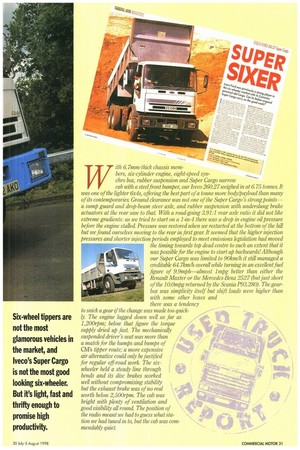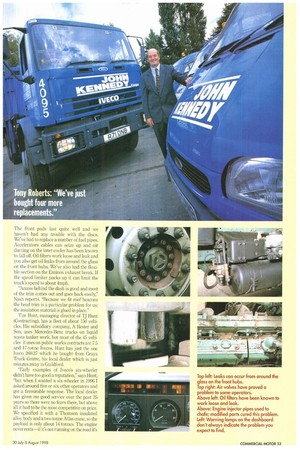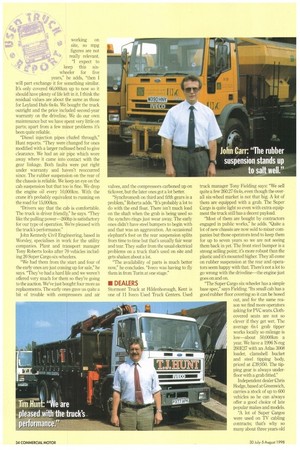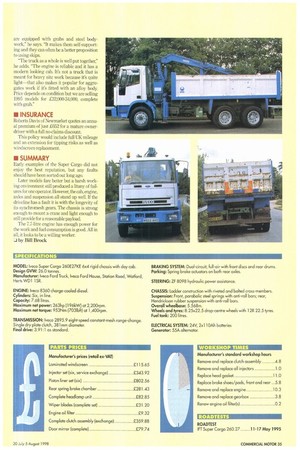VII LI. NG
Page 32

Page 33

Page 34

Page 35

Page 36

Page 37

If you've noticed an error in this article please click here to report it so we can fix it.
• It was a sign of the times earlier this year when Iveco Ford Truck launched a national used vehicle programme among a select band of its main dealers. The scheme is intended to bolster the values of the growing number of younger second-hand trucks which are coming onto the market as the result of the various lease and contract-hire deals being made with new trucks.
It covers the whole range from 3.5-tonne vans to 44-tonne tractors, including vehicles with specialist bodywork.
Iveco Ford holds the vehicles centrally and allocates them to the dealers in the programme according to demand. All vehicles in the scheme are refurbished and valeted according to an 80-point plan. They are offered for sale with a warranty and, where appropriate, a test certificate with at least six months to run.
Customers can also take advantage of any existing financial and operational support llo•
Wbers, six-cylinder engine, eight-speed syn
ith 6.7mm-thick chassis mem
Wbers, six-cylinder engine, eight-speed syn
chro box, rubber suspension and Super Cargo narrow ,...,...„ cab with a steel front bumpo; our Iveco 260.27 weighed in at 6.75 tonnes It was one of the lighter 6x4s, offering the best part of a tonne more body/payload than many of its contemporaries. Ground clearance was not one of the Super Cargo's strong points
a sump guard and drop-beam steer axle, and rubber suspension with underslung brake actuators at the rear saw to that. With a road-going 3.91;1 rear axle ratio it did not like extreme gradients: as we tried to start on a 1-in-4 there was a drop in engine oil pressure before the engine stalled. Pressure was restored when we restarted at the bottom of the hill but we found ourselves moving to the rear in first gear It seemed that the higher injection Pressures and shorter injection periods employed to meet emissions legislation had moved the timing towards top dead centre to such an extent that it was possible for the engine to start up backwards! Although our Super Cargo was limited to 90km/h it still managed a creditable 64.7km/h overall while turning in an excellent fuel figure of 9.9mph—almost 1mpg better than either the Renault Maxter or the Mercedes-Benz 2527 (but just short of the 10.0mpg returned by the Scania P93.280). The gearbox was simplicity itself but shift loads were higher than with some other boxes and
there was a tendency to snick a gear if the change was made too quick ly The engine lugged down well as far as „ 1,200rpm; below that figure the torque supply dried up fast. The mechanically suspended driver's seat was more than a match for the humps and bumps of CM's tipper route; a more expensive air alternative could only be justified for regular off-road work. The six wheeler held a steady line through bends and its disc brakes worked well without compromising stability but the exhaust brake was of no real worth below 2,500rpm. The cab was bright with plenty of ventilation and good visibility all round. The position of \ the radio meant we had to guess what station we had tuned in to, but the cab was commendably quiet.
„It ; 0 packages from
EuroTruck Transolver and EuroTruck Transolver and Contracts.
'7)Ptlig, 0 • EVOLUTION The old six-wheeled Ford Cargo with its major proprietary components held a strong position in the tipper and especially mixer markets with a 9.5% share in 1991, its last full year of production. For the all-new Iveco Super Cargo, introduced towards the end of 1992, it was a hard act to follow. With no track record to back it up, market share dipped to just 3.4% in the mid-nineties before the full potential of its low unladen weight was exploited. Its low kerbweight makes it equally attractive for tipper, tanker, mixer and refuse operations; so far this year it is taking 6.5% of the market.
Two power options are available. The well proven 5.9-litre engine produces 227hp at 2,700rpm and maximum torque of 5091bft at 1,400rpm. The 7.7-litre unit develops 266hp at 2,200rpm and 703lbft at 1,400rpm. Both engines work through an Iveco nine-speed synchromesh transmission incorporating a 330mm single-dry-plate clutch.
At the rear the deep C-section frame runs on Hendrickson rubber suspension and Rockwell axles with inter and cross-axle differentials for tipper models, Disc brakes with oil-filled hubs are standard on the front axle, which has a design weight of 7.1 tonnes. The rear bogie is designed for 19 tonnes.
The six-wheeler Super Cargo uses the same coil-sprung day/sleeper cab as the lighter 4x2 Super Cargo 17-tonner.
• OPERATORS
John Carr joined Leicestershire County Council about 10 years ago. As transport manager he runs a fleet of some 200 vehicles and numerous items of plant equipment, used mainly for road maintenance and construction. The fleet includes 40 Ivecos, 40 Leyland Dais and 20 six-wheelers from a number of other makes, including some Volvos.
"We buy a type of vehicle rather than because it is a particular make," says Carr. "The six-wheelers are dual-purpose vehicles which serve as both gritters and bulk tippers; the swap-body system can be changed over in about 15 minutes. We lase out on payload a little but we gain with the flexibility it offers. They're used all the year round—with dedicated bodies some would be standing about for months on end doing nothing.
"We have a total of 13 Super Cargo 260.27s," he adds. "We bought the first one about four years ago: they followed on behind. the Cargo 2424s. We plan for a seven-year life but may extend use depending on the condition. Our mileage is very low, only about 25,000km a year, but in a salt environment corrosion is a big issue for us. The chassis are re-waxed every year and the 2424s are still in good condition after 10 years. We chose the higher power option to run with a snowplough on the front. The rubber suspension stands up to the salt well. One concession we have made is the use of a marine alternator: trawler alternators don't suffer from salt ingress and neither do ours!
"Autolube is retrofitted by Lubspec, which designs the system to look after the body equipment as well as the chassis components," Carr explains. "We haven't sold any of the Super Cargos yet but when the time comes I hope they will still have a reasonable residual value fitted with the tipper bodies."
Workshop foreman Jez Nash reports that they're heavy on clutches. "They last 11 to 12 months on this work," he says. "Air valves have been a constant problem. We have changed one gearbox and a propshaft. Warning lamps don't always indicate the problem you expect to find—wear sensors on the front and rear brakes snap off and so indicate that the pads or linings are worn.
The front pads last quite well and we haven't had any trouble with the discs. We've had to replace a number of fuel pipes. Accelerators cables can seize up and air ducting on the inter-cooler has been known to fall off. Oil filters work loose and leak and you also get oil leaks from around the glass on the front hubs. We've also had the flexible section on the Eminox exhaust break. If the speed limiter packs up it can limit the truck's speed to about 4mph.
"Access behind the dash is good and most of the trim comes out and goes back easily," Nash reports. "Because we fit roof beacons the head trim is a particular problem for us; the insulation material is glued in place."
Tim Hunt, managing director of TJ I lunt (Contracting), has a fleet of about 150 vehicles. his subsidiary company, A Hester and Son. uses Mercedes-Benz trucks on liquid waste tanker work, but most of the 45 vehicles it uses on public works contracts are 7.5 and 17-tonne Ivecos. Hunt has just the one Iveco 260.27 which he bought from Grays Truck Centre, his local dealer which is just minutes away in Guildford.
"Early examples of Iveco's six-wheeler didn't have too good a reputation," says Hunt, "but when I wanted a six-wheeler in 1996 I asked around five or six other operators and got a favourable response. The local dealer has given me good service over the past 25 years so there were no fears there, hut above all it had to be the most competitive on price. We specified it with a Thomson insulated alloy body and a two-tonne Atlas crane, so the payload is only about 14 tonnes. The engine never rests—if its not ruiniiiig on the road it's working on site, so mpg figures are not really relevant. "I expect to .., keep this six wheeler for five years," he adds, "then I will part exchange it for something similar. It's only covered 66,000km up to now so it should have plenty of life left in it. I think the residual values are about the same as those for Leyland Dafs 6x4s. We bought the truck outright and the price included second-year warranty on the driveline. We do our own maintenance but we have spent very little on parts; apart from a few minor problems it's been quite reliable.
"Diesel injection pipes chafed through," Hunt reports. "They were changed for ones modified with a larger radiused bend to give clearance. We had an air pipe which wore away where it came into contact with the gear linkage. Both faults were put right under warranty and haven't reoccurred since. The rubber suspension on the rear of the chassis is reliable. We keep an eye on the cab suspension but that too is fine. We drop the engine oil every 10,0001cm. With the crane it's probably equivalent to running on the road for 15,000km.
"Drivers say that the cab is comfortable. The truck is driver friendly," he says. "They like the pulling power-260hp is satisfactory for our type of operation. We're pleased with the truck's performance."
John Kennedy Civil Engineering, based in Worsley, specialises in work for the utility companies. Plant and transport manager Tony Roberts looks after 70 vehicles including 20 Super Cargo six-wheelers.
"We had them from the start and four of the early ones are just coming up for sale," he says. 'They've had a hard life and we weren't offered very much for them so they're going to the auction. We've just bought four more as replacements. The early ones gave us quite a bit of trouble with compressors and air
valves, and the compressors carboned up on tickover, but the later ones got a lot better.
"Synchromesh on third and fifth gears is a problem," Roberts adds. "It's probably a lot to do with the end float. There isn't much load on the shaft when the grab is being used so the synchro rings just wear away. The early ones didn't have steel bumpers to begin with and that was an aggravation. An occasional elephant's foot on the rear suspension splits from time to time but that's usually fair wear and tear. They suffer from the usual electrical problems on a truck that's used on site and gets shaken about a lot.
"The availability of parts is much better now," he concludes. "Iveco was having to fly them in from Turin at one stage."
• DEALERS
Stormont Truck at Hildenborough, Kent is one of 11 Iveco Used Trucb: Centers. Used
truck manager Tony Fielding says: "We sell quite a few 260.27 6x4s, even though the overall six-wheel market is not that big. A lot of them are equipped with a grab. The Super Cargo is quite light so even with extra equipment the truck still has a decent payload.
"Most of them are bought by contractors engaged in public works," he adds. "Quite a lot of new chassis are now sold to mixer companies but those operators tend to keep them for up to seven years so we are not seeing them back in yet. The front steel bumper is a strong selling point: it's more robust than the plastic and it's mounted higher. They all come on rubber suspension at the rear and operators seem happy with that. There's not a lot to go wrong with the driveline—the engine just goes on and on.
"The Super Cargo six-wheeler has a simple base spec," says Fielding. "Its small cab has a good rubber floor covering so it can be hosed out, and for the same reason we find more operators asking for PVC seats. Clothcovered seats are not so clever if they get wet. The average 6x4 grab tipper works locally so mileage is low—about 50,0001on a year. We have a 1996 N-reg 260E27 with an Atlas 3008 loader, clamshell bucket and steel tipping body, priced at £39,950. The tipping gear is always underfloor with a grab fitted."
Independent dealer Chris Hodge, based at Greenwich, carries a stock of up to 600 vehicles so he can always offer a good choice of late popular makes and models.
"A lot of Super Cargos were used on TV cabling contracts; that's why so many about three years old are equipped with grabs and steel bodywork," he says. "It makes them self-supporting and they can often be a better proposition to using skips.
"The truck as a whole is well put together," he adds. "The engine is reliable and it has a modern looking cab. It's not a truck that is meant for heavy site work because it quite light—that also makes it popular for aggregates work if it's fitted with an alloy body. Price depends on condition but we are selling 1995 models for £32,000-34,000, complete with grab."
• INSURANCE
Roberts Davis of Newmarket quotes an annual premium of just £652 for a mature ownerdriver with a full no-claims discount.
This policy would include full UK mileage and an extension for tipping risks as well as windscreen replacement.
• SUMMARY
Early examples of the Super Cargo did not enjoy the best reputation, but any faults should have been sorted out long ago.
Later models fare better but a harsh working environment still produced a litany of failures for one operator. However, the cab, engine, axles and suspension all stand up well. If the driveline has a fault it is with the longevity of its synchromesh gears. The chassis is strong enough to mount a crane and light enough to still provide for a reasonable payload.
The 7.7-litre engine has enough power for the work and fuel consumption is good. All in all, it looks to be a willing worker.
-I by Bill Brock












































































































